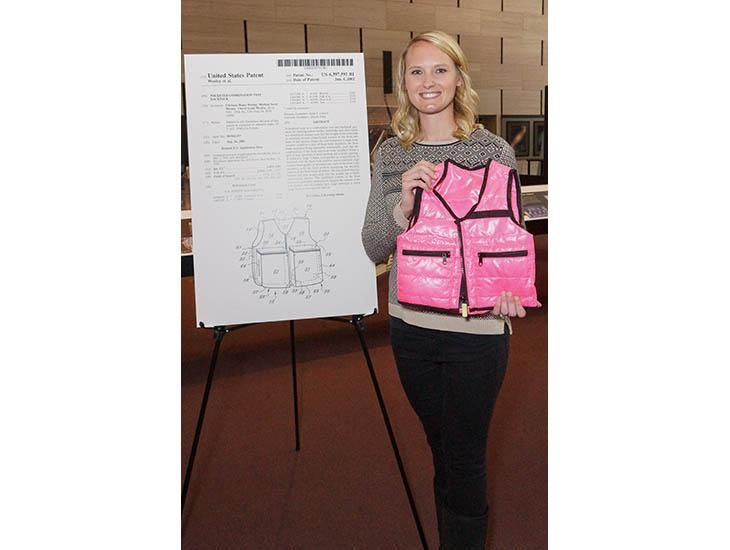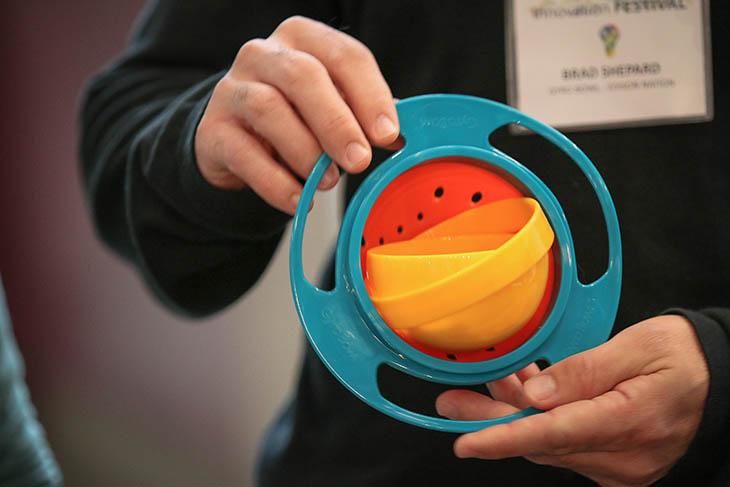Here’s What You Missed at the Smithsonian Innovation Festival
Inventors and museum staff alike inspired the crowd to see the world through the prism of innovation
/https://tf-cmsv2-smithsonianmag-media.s3.amazonaws.com/filer/99/5b/995b99a2-0d60-4c7a-93c4-9918b5f49be3/uspto_air__space_museum_photos_by_michael_a_cleveland_dms_11-1-2014dsc08177_2014edit.jpg)
Christen Bell was just 11 years old when she came up with a vest-backpack hybrid. But the sixth-grade science project—an attempt to evenly distribute the heavy loads students carry—has now become a patented product, the Vestpakz, licensed by the backpack company Eastsport.
“It’s important to encourage creativity and an innovative spirit in kids,” says Cheryl Wooley, Christen’s mother and CEO of the company. “That’s how we got started.”
The Vestpakz was one of many inventions showcased at the Innovation Festival held this past weekend at the National Air and Space Museum. The festival was the inaugural event of a five-year collaboration between the Smithsonian Institution and the United States Patent and Trademark Office, during which the USPTO will provide funding for innovation-related exhibitions and programs at the museums.
“With our partner, we are highlighting and celebrating patent and trademark technology within the United States. We want to showcase people who have really inspired the innovative spirit in America,” says Cat Aboudara, program coordinator at the Smithsonian Associates and an organizer of the event.
Individuals, large and small companies, universities, museums and government agencies displayed and demonstrated their original ideas—everything from an inflatable seatbelt to a system that creates medical-grade oxygen from two dry, inert powders, one of which releases oxygen molecules once a chemical reaction takes place and the other, which acts like a catalyst to make the reaction occur. It’s these types of inventions, many of which stem from a person’s everyday struggles, that show us the future will continue seeing vast improvements in everyday life, from the creating safer environments to saving lives.
Inventors shared stories of how they transformed their ideas into viable products. When Brad and Melinda Shepard came up with the concept of a spill-proof bowl, they created an initial prototype and then applied for a patent. They also pitched the idea to Edison Nation, a licensing company that selects product ideas and strategizes to commercialize them. Edison Nation ultimately turned the original prototype into the marketable Gyro Bowl, a trendy 360-rotational bowl, and helped get it out in store shelves. “There are great ideas out there, but people don’t always have the resources to get into the marketplace themselves,” says Louis Foreman, CEO of Edison Nation. “We get thousands of ideas each month from around the world and have to determine if the concept is patentable, if it can be viably manufactured and if there is a demand for the product.”
The USPTO receives hundreds of thousands of patent applications each year; next spring, the agency will issue the 9 millionth patent. According to Richard Maulsby, associate commissioner at the USPTO and project coordinator for the collaboration with the Smithsonian Institution, patent examiners ask three primary questions:
- Is it something new or is it an improvement on an idea?
- How would this product be utilized?
- And, is this original in its field?
The applicant has to go through eight steps, during which they determine if they need a design, utility or plant patent and they decide if they will file themselves or use an agent. The process can take many years because often, the first application is rejected and the applicant has to file an appeal or request for reconsideration. The process can take years. “Usually we tell people that it’s a good idea to get a patent attorney,” Maulsby says. Corporations submit approximately 70 percent of the applications, independent inventors account for about 15 to 20 percent and colleges and universities enter the remainder. “This patent system is the reason why we have been the envy of the world since the 19th century for technology and advancement,” he says.
Representatives from several Smithsonian museums led hands-on activities designed to introduce kids to problem solving and the STEM fields. Eager young visitors built from Legos aircraft and devices capable of rolling along a miniature high wire hung within the museum. The Cooper Hewitt, Smithsonian Design Museum encouraged teams to use simple, inexpensive material like small cardboard pieces and paper to find a solution to simple challenges such as coming up with a design to stop students from running in hallways and then creating a prototype of that idea.
“Anybody can be an inventor,” says Maulsby. “You just have to have the inspiration and drive.”





